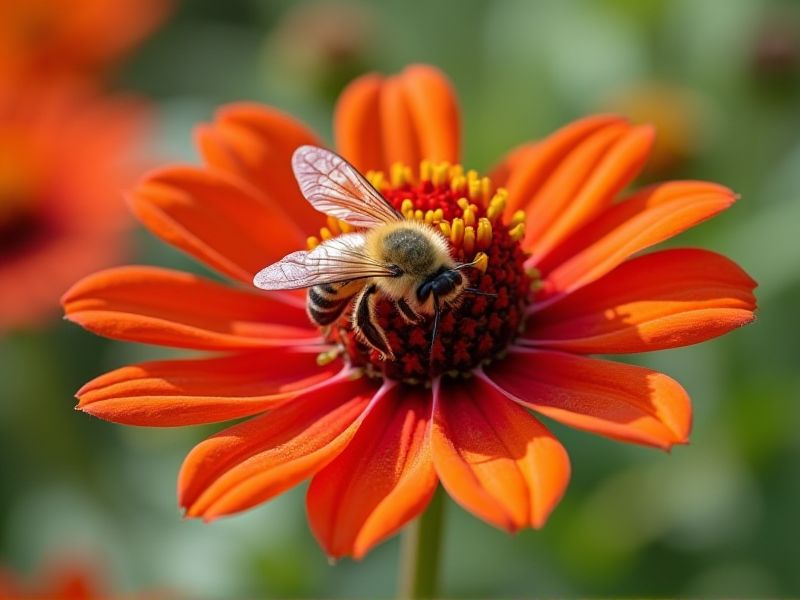
Sunflowers, with their large, vibrant blooms, serve as a magnet for bees, providing ample nectar and pollen. Cosmo flowers, known for their delicate petals, offer a rich food source while enhancing garden aesthetics. Zinnias, available in diverse colors, not only bring joy to your landscape but also keep pollinators buzzing throughout the growing season. Marigolds attract bees with their bright hues and are easy to grow, making them a favorite among gardeners. Consider incorporating these annuals into your garden to support bee populations and promote biodiversity.
List of some Annual plants that attract bees
- Borage (Borago officinalis)
- Sunflower (Helianthus annuus)
- Zinnia (Zinnia elegans)
- Cosmos (Cosmos bipinnatus)
- Alyssum (Lobularia maritima)
- Cornflower (Centaurea cyanus)
- Snapdragons (Antirrhinum majus)
- Marigold (Tagetes erecta)
- Sweet Pea (Lathyrus odoratus)
- Calendula (Calendula officinalis)
Important things about Annual plants that attract bees
Rapid Growth Cycle
Annual plants, such as sunflowers and zinnias, have a rapid growth cycle that makes them essential for gardeners looking to attract bees. These vibrant flowers bloom within a single growing season, providing a continuous source of nectar and pollen that supports local bee populations. Their quick lifecycle not only enhances your garden's beauty but also contributes to ecological health by promoting biodiversity. By strategically planting these annuals, you can help create a thriving habitat for pollinators, ensuring a robust ecosystem.
Seasonal Blooming
Annual plants such as cosmos, zinnias, and marigolds are excellent for attracting bees, making them vital additions to any garden aiming to support pollinator populations. Cosmos, with their vibrant blooms and easy-care nature, provide a rich nectar source throughout the summer months. Zinnias, known for their colorful petals and long-lasting flowers, bloom continuously until the first frost, offering a feast for bees and other pollinators. Planting a variety of these annuals ensures a diverse and appealing habitat, helping to promote a healthy ecosystem while enhancing your garden's beauty.
Bright, Vibrant Colors
Annual plants that attract bees offer a stunning array of bright, vibrant colors, making them perfect for gardens and landscapes. Sunflowers (Helianthus annuus), with their towering stems and large, golden blooms, provide a rich source of nectar. Zinnias (Zinnia elegans) showcase vibrant hues, ranging from fiery reds to sunny yellows, enticing bees with their easy access to pollen. By incorporating these colorful annuals into your garden, you not only enhance its visual appeal but also support essential pollinators in their critical role within the ecosystem.
High Nectar Production
Annual plants known for high nectar production are essential for attracting bees, which play a crucial role in pollination. Varieties such as sunflowers, zinnias, and cosmos not only bring vibrant colors to your garden but also provide a rich food source for these pollinators. Planting a diverse array of these vibrant blooms will encourage a healthy bee population, enhancing the overall productivity of your garden. By incorporating these annuals, you can create an inviting habitat that supports beneficial insects and fosters a thriving ecosystem.
Pollinator-Friendly Varieties
Annual plants that attract bees are essential for promoting biodiversity and supporting healthy ecosystems. Varieties such as **Cosmos**, **Sunflowers**, and **Zinnias** not only provide vibrant color to your garden but also serve as crucial food sources for various bee species. Incorporating these pollinator-friendly plants enhances your garden's productivity while fostering a more sustainable environment. Choosing native annuals can further optimize your garden, aligning with local bee populations' preferences and behavior.
Easy To Grow From Seed
Annual plants that attract bees are excellent choices for gardening enthusiasts looking to support pollinator populations while enhancing their outdoor spaces. Flowers like sunflowers (Helianthus annuus), cosmos (Cosmos bipinnatus), and zinnias (Zinnia elegans) are not only easy to grow from seed but also provide vibrant colors and rich nectar sources for bees. By planting these varieties, you can create a thriving habitat that encourages diverse bee species to flourish. Incorporating such annuals into your garden design not only enhances biodiversity but also promotes a healthier ecosystem.
Continuous Flowering Season
Many annual plants are celebrated for their ability to produce continuous blooms throughout the growing season, making them ideal for attracting bees and other pollinators. Varieties such as cosmos, zinnias, and marigolds thrive in sunny gardens, offering vibrant colors and abundant nectar. Planting these species in clusters can significantly increase pollinator activity, enhancing both your garden's beauty and ecosystem health. To maximize bee attraction, consider incorporating plants that bloom at different times, ensuring your garden remains a lively habitat from spring until frost.
Low Maintenance Requirements
Annual plants such as cosmos, sunflowers, and calendula are excellent options for attracting bees while requiring minimal upkeep. These vibrant blooms flourish throughout the growing season, providing essential nectar and pollen for local bee populations. Low maintenance characteristics include drought tolerance and resistance to common pests, making them ideal for gardeners seeking to promote biodiversity without extensive effort. By incorporating these annuals into your garden, you not only enhance its aesthetic appeal but also support crucial pollinators in your environment.
Attract Diverse Bee Species
Annual plants such as sunflowers, cosmos, and zinnias are excellent choices for attracting diverse bee species to your garden. These flowering plants bloom throughout the growing season, providing ample nectar and pollen for various bee populations. Sunflowers, with their large, open blooms, are particularly appealing to honeybees and native bumblebees, while cosmos offer a wide range of colors that further entice different bee species. By incorporating these vibrant annuals into your landscape, you can create a thriving habitat that supports essential pollinators and promotes biodiversity.
Support Local Ecosystems
Annual plants, such as sunflowers (Helianthus annuus) and zinnias (Zinnia elegans), are excellent choices for attracting bees to your garden. These colorful blooms not only provide nectar and pollen, essential for bee nutrition, but also contribute to the overall health of local ecosystems. By incorporating a variety of annuals into your landscape, you can create vibrant habitats that support diverse bee populations and enhance pollination for nearby crops. Embracing these flowering plants fosters biodiversity and helps sustain vital interactions within your garden's ecosystem.
